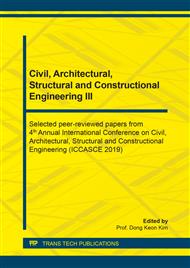[1]
G. Sant, M. Dehadrai, D. Bentz, P. Lura, C. F. Ferraris, J. W. Bullard, J. Weiss, Detecting the fluid-to-solid transition in cement pastes, Concre. Int. 31 (2009) 53-58.
Google Scholar
[2]
G. Barluenga, J. Puentes, I. Palomar, C. Guardia, Methodology for monitoring Cement-Based Materials at Early Age combining NDT techniques, Construct. Build. Mater. 193 (2018) 373-383.
DOI: 10.1016/j.conbuildmat.2018.10.205
Google Scholar
[3]
D. P. Bentz, A review of early-age properties of cement-based materials, Cement Concrete. Res. 38 (2008) 196-204.
DOI: 10.1016/j.cemconres.2007.09.005
Google Scholar
[4]
P. K. Mehta, P. J. Monteiro, Concrete: microstructure, properties, and materials, (2017).
Google Scholar
[5]
R. Ylmen, et al. Early hydration and setting of Portland cement monitored by IR, SEM and Vicat techniques, Cement Concre. Res. 39 (2009) 433-439.
DOI: 10.1016/j.cemconres.2009.01.017
Google Scholar
[6]
E. D. Dzaye, G. De Schutter, D. G. Aggelis, Study on mechanical acoustic emission sources in fresh concrete, Arch. Civ. Mech. Eng. 18, (2018) 742-754.
DOI: 10.1016/j.acme.2017.12.004
Google Scholar
[7]
P. Hewlett, M. Liska, Lea's chemistry of cement and concrete, Butterworth-Heinemann, (2019).
Google Scholar
[8]
S. Guo, et al. Delaying the hydration of Portland cement by sodium silicate: Setting time and retarding mechanism, Constr. Build. Mater. 205 (2019) 543-548.
DOI: 10.1016/j.conbuildmat.2019.02.041
Google Scholar
[9]
L. Zhang, X. Qian, C. Yu, M. Fang, K. Qian, J. Lai, Influence of evaporation rate on pore size distribution, water loss, and early-age drying shrinkage of cement paste after the initial setting, Constr. Build. Mater. 226 (2019) 299-306.
DOI: 10.1016/j.conbuildmat.2019.07.143
Google Scholar
[10]
H. Sleiman, A. Perrot, S. Amziane, A new look at the measurement of cementitious paste setting by Vicat test, Cement Concre. Res. 40 (2010) 681-686.
DOI: 10.1016/j.cemconres.2009.12.001
Google Scholar
[11]
S. Amziane, C. F. Ferraris, Cementitious paste setting using rheological and pressure measurements, ACI Mater. J. 104 (2007) 137.
DOI: 10.14359/18576
Google Scholar
[12]
A. Shukla, A. Prakash, S. Rohani, Particles settling studies using ultrasonic techniques, Powder Technol. 177 (2007) 102-111.
DOI: 10.1016/j.powtec.2007.02.003
Google Scholar
[13]
K. H. Khayat, T. V. Pavate, J. Assaad, C. Jolicoeur, Analysis of variations in electrical conductivity to assess stability of cement-based materials, Mater. J. 100(4) (2003).
Google Scholar
[14]
Sch Leibinger Testing Systems, Online at: www.schleibinger.com/cmsimple/en/? Setting_and_Maturity:Ultrasonic_Setting_Measurement.
Google Scholar
[15]
A. Gibson, D. Ciancio, Early-age Ultrasonic Testing of Concrete and Shotcrete using Embedded Sensors, Nondestructive testing of materials and structures, Springer, Dordrecht, (2013) 485-490.
DOI: 10.1007/978-94-007-0723-8_69
Google Scholar
[16]
E. K. Tschegg, et al. Energy dissipation capacity of fibre reinforced concrete under biaxial tension-compression load. Part I: Test equipment and work of fracture, Cement Concre. Comp. 62 (2015) 192-203.
DOI: 10.1016/j.cemconcomp.2015.07.002
Google Scholar
[17]
W. Kurdowski, Cement and concrete chemistry, Springer Sci. Business, (2014).
Google Scholar
[18]
A. Bajza, I. Rousekova, Technologia betonu, Jaga Group, ISBN 80-8076-032-2 (2006).
Google Scholar
[19]
P. C. Aitcin, High-performance concrete, CRC press, (2011).
Google Scholar
[20]
S. Adu-Amankwah, L. Black, M. Zajac, Effect of cement grade and fineness of slag on the early age to medium-term properties of binary blends, 33rd Cement Concre. Sci. Conf. Leeds (2013).
Google Scholar
[21]
W. Franus, R. Panek, M. Wdowin, SEM investigation of microstructures in hydration products of portland cement, 2nd Int. Multidiscip. Microsco. Microanaly. Congr. (2015) 105-112.
DOI: 10.1007/978-3-319-16919-4_14
Google Scholar


